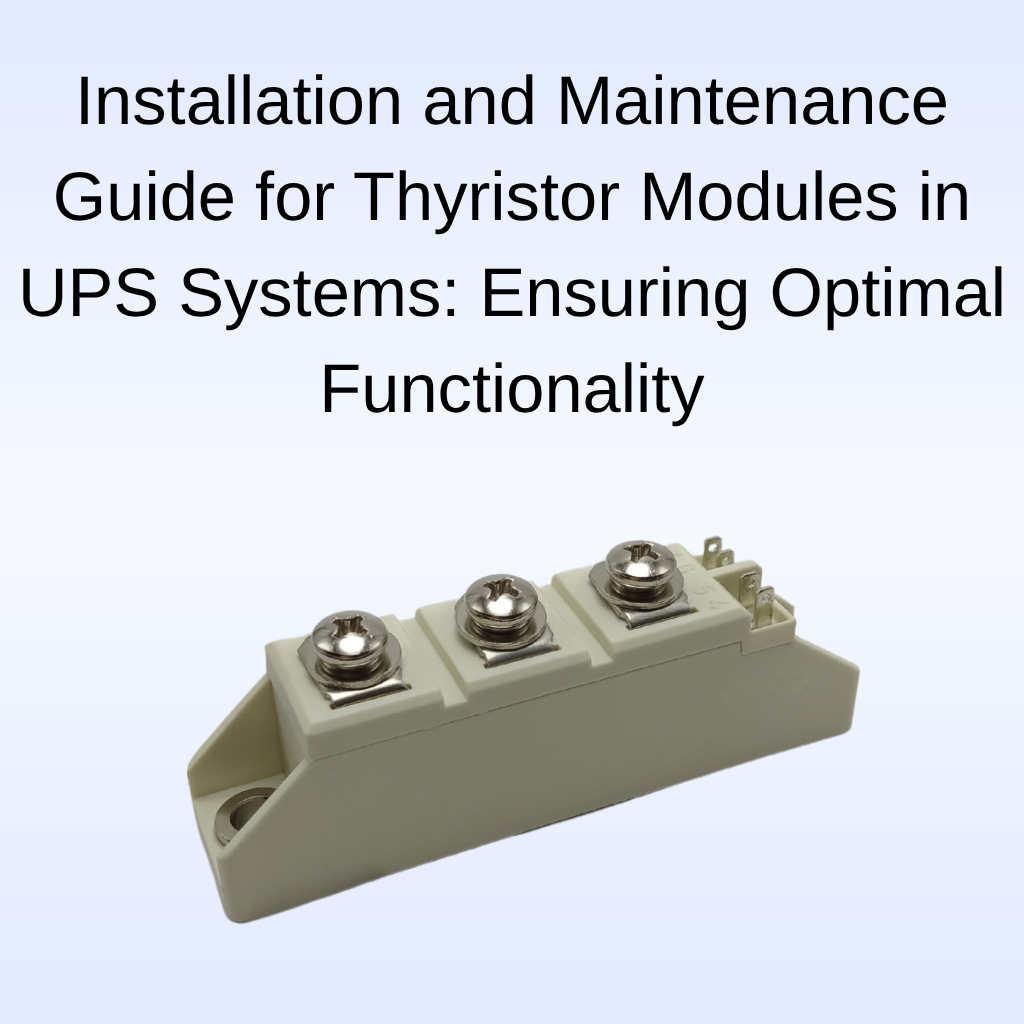Installation and Maintenance Guide for Thyristor Modules in UPS Systems: Ensuring Optimal Functionality
Thyristor modules are essential for the reliable operation of Uninterruptible Power Supply (UPS) systems, which are responsible for providing uninterrupted power to critical equipment. To ensure optimal performance, thyristor modules need to be installed and maintained properly. This guide offers a detailed overview of how to install and maintain thyristor modules, focusing on important aspects such as high surge current, low on-state voltage, and industrial phase control.
Step 1: Installation of Thyristor Modules in UPS Systems
The installation process is crucial to the performance and longevity of thyristor modules within a UPS system. Proper installation ensures that the system runs efficiently, with minimal risk of component failure. Key steps for installing thyristor modules include:
Compact Package and Space Considerations: Thyristor modules are usually designed in a compact package, making them easier to integrate into the UPS system. Before installation, ensure that the available space allows for proper ventilation. Adequate airflow is essential to prevent overheating, which could significantly reduce module lifespan and system efficiency.
Corrosion Protection: Thyristor modules are often anodized to resist corrosion. During installation, check that the anodized surfaces are intact. Anodizing enhances durability, particularly in environments where exposure to moisture or corrosive elements is common.
Power Converter Integration: Thyristor modules are integral to the power converter function of the UPS. Ensure the modules are properly connected to the power converter for efficient DC to AC conversion. Ensure all electrical connections are secure to avoid inefficiencies or potential UPS system failure.
Handling High Surge Current: UPS systems often experience high surge current, especially during startup or when switching loads. Ensure the thyristor modules selected are rated for high surge current to protect the UPS system from power spikes and avoid damage to sensitive components.
Step 2: Testing the Installation
After installing the thyristor modules, it is important to test the system to verify that everything is functioning properly. Proper testing ensures that the UPS system operates efficiently under all conditions:
Low On-State Voltage Testing: The low on-state voltage of thyristor modules helps reduce power losses and improves system efficiency. Ensure that the modules are within the desired voltage range for optimal performance.
Industrial Phase Control Testing: The industrial phase control feature of thyristor modules stabilizes voltage in industrial settings. Confirm that phase control is operational and delivering stable power, particularly under varying load conditions.
Surge Current Testing: Test the system's ability to handle high surge current during load transitions. The UPS should efficiently absorb surge currents without causing damage or reducing performance.
Step 3: Maintenance of Thyristor Modules
Regular maintenance is crucial for ensuring the long-term performance of thyristor modules in UPS systems. Proper maintenance practices prevent premature failure and extend the modules’ service life:
Routine Inspections: Regularly inspect thyristor modules for physical damage such as discoloration, cracks, or corrosion. Replace any damaged modules to avoid compromising system functionality.
Cleaning and Debris Removal: Periodically clean the modules to prevent dust buildup, which can impair performance. Use compressed air or a soft brush to clean the modules and surrounding components, ensuring that the system stays free from debris.
Thermal Management: Ensure that the cooling system, including fans and heat sinks, is functioning properly. The modules generate heat during operation, and improper cooling could lead to overheating and decreased performance.
Surge Current Monitoring: Continuously monitor the system for surge current issues. If the UPS system regularly experiences surge currents beyond the rated capacity of the modules, consider adjusting the load or upgrading the system’s surge handling capability.
Conclusion
Proper installation and maintenance of thyristor modules are vital for ensuring the reliability and efficiency of UPS systems. By focusing on key features such as high surge current handling, low on-state voltage, and industrial phase control, you can ensure that the system operates at its highest efficiency. Regular maintenance, including inspections, cleaning, and monitoring, will prolong the lifespan of the thyristor modules and the UPS system, ensuring the continuous and stable operation of critical equipment.
READ MORE:
Purchasing and Supply of Thyristor Modules for UPS Systems: Key Factors for UPS Systems
Installation and Maintenance Guide for Thyristor Modules in UPS Systems: Ensuring System Efficiency
Installation and Maintenance Guide for Thyristor Modules in UPS Systems
Installation and Maintenance Guide for Thyristor Modules in UPS Systems: Long-Term Reliability

